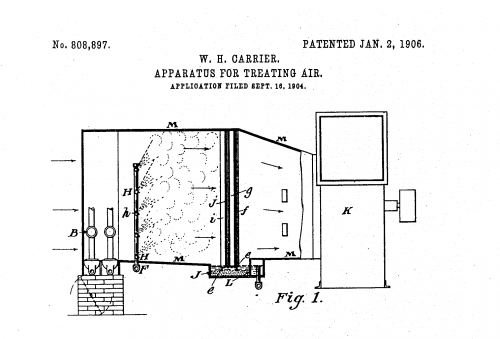When San Patricio Electric Cooperative began providing electric service in 1938, air conditioning was not only primitive, it was a luxury only the very wealthy could afford. Our rural residents spent sweltering summer days with open windows, fanning themselves, or finding much-needed relief at the nearest swimming hole.
Now air conditioning is seen as a necessity, and most—if not all—of our members enjoy the cooling comfort of the AC on our all-to-common triple digit days. As the summer approaches, we thought it was worth taking a look back at the humble beginnings of our beloved air conditioner.
Building the foundations of AC
In 1902, a 25-year-old engineer from New York named Willis Carrier was tasked with solving a humidity problem that was causing magazine pages to wrinkle at Sackett-Wilhelms Lithographing and Publishing Company in Brooklyn. Through his experiments, Carrier found that he could dry air by passing it through water-cooled coils, effectively controlling humidity. Within a year, he patented his “apparatus for treating air” and created what is now considered the foundation of modern air conditioning.

Cool air for the New York Stock Exchange
Air conditioning specifically intended to cool people was first installed at the New York Stock Exchange, which opened in 1903. The air conditioning system was designed by Alfred Wolff, also a New York engineer. Wolff’s system used three ammonia-absorption machines, each with a cooling capacity equal to 150 tons of ice. Early systems like this were huge and best suited for industrial use. The NYSE’s system was deeply integrated into the architecture of the building.
The public’s first experience with indoor cooling
In 1904, organizers at the St. Louis World’s Fair used mechanical refrigeration to cool all the rooms in the Missouri State Building—except for the lavatories and library. At the time, mechanical refrigeration was an established, but uncommon, technology. It was typically only found in ice-making facilities. The State Fair was the first time of record that mechanical refrigeration was used to cool a building for public use and comfort.
However, the cool air was short lived—just two weeks before the fair was scheduled to close, a fire that began in the kitchen destroyed most of the building.
Air conditioning prompts the summer blockbuster
Carrier followed up his initial invention with a centrifugal chiller in 1922. He refined his initial apparatus and added a central compressor, which reduced the size of his mechanical air conditioning unit. The change also improved system reliability and lowered the cost of air conditioners.
He debuted the device at the Rivoli Theater in Times Square on Memorial Day weekend in 1925. Over the next few years, these systems were adopted by more theaters and people flocked to them on hot summer days, giving rise to the summer blockbuster.
Bringing air conditioning home
Despite improvements in air conditioning technology, the units were far too large and costly for use in residential homes. The first home air conditioner didn’t make its debut until 1929 when Frigidaire introduced a room cooler small enough for residential use. However, there were still challenges to the public widely adopting the device. The system required a 400-pound condensing unit and 200-pound cabinet. Plus, it costs $1,000 to install. (Adjusted for inflation, that would run just over $14,000 in 2017.)
Over the years, several more companies worked to create even smaller, less expensive air conditioning units for general public use. In the early 1930s, it seemed Henry Galson finally hit the mark. Galson created a compact, inexpensive window air conditioner. He sold 43,000 systems by 1947.
Air conditioning goes mainstream

By the 1960s window air conditioning became much more affordable and most new homes were built with central air conditioning systems. American’s continued to install air conditioning at a rapid rate well into the 1970s.
Then the energy crisis hit. Lawmakers suddenly passed laws to reduce energy consumption and eventually created a federal energy efficiency standard for air conditioner manufacturers. This prompted even further innovations for air conditioning technology that have greatly improved energy efficiency. Air conditioners today use about 50 percent less energy than they did in 1990, according to the U.S. Department of Energy.
Now, almost every home in America has some form of air conditioning. According to the Energy Information Administration, 87 percent of households—about 100 million U.S. homes—have air conditioning today.
